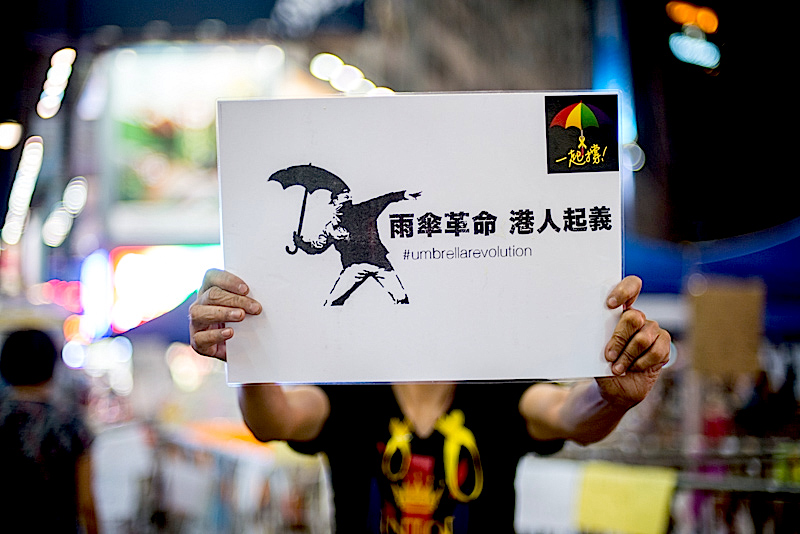In stark contrast to the upsetting images of tear gas, pepper spray and police brutality, Hong Kong’s pro-democracy protests have inspired an outpouring of both digital creativity and street art. The umbrella motifs whipped up by the dab hands of the city’s graphic designers, were shared far and wide over the art gallery that is the internet, while everything from sticky notes to bunk beds, banners, and, of course, umbrellas made the rainbow of this colour-coded movement glow vividly on the streets.

Lennon Wall
But as the protesters continue to add their neon messages of hope to the now-renamed “Lennon Wall” – belonging to the government headquarters – and fold yellow origami umbrellas in their thousands, few have given much, if any, thought as to where their work will end up if and when the streets are finally cleared.

Origami umbrellas
After learning that Lennon Wall will most likely find its final resting place in black bin bags, Meaghan McGurgan – the editor of Hong Kong theatre portal HKELD and artistic director of Shakespeare in the Port – set about contacting the creators of arguably the movement’s most iconic work so far, Umbrella Man and the Umbrella Bauhinia.

Umbrella Man
On hearing that neither piece had been offered a home for after their purpose has been served, she endeavoured to create exactly that – not just for the most showy installations, but for all imaginative offerings inspired by the Umbrella Revolution.

The Umbrella Bauhinia
UMAP, which stands for Umbrella Movement Art Preservation, aims to provide three services: a platform on which to preserve the Occupy art digitally through photographs; a place for people to submit their own work; and a fixer, finding homes or providing storage space for the work and organising transport for larger pieces. No art will be sold, no profits will be made and all services are free.

An on-street creation
Speaking to Coconuts Hong Kong about the team of five behind UMAP, Meaghan said: “As supporters of the Occupy movement and art lovers, we want to see the artwork that has been created over the past few weeks protected. It would be heartbreaking to see any of it end up in the trash because of lack of storage space.”
“The purpose isn’t to sell the art for profit or desensitise the issue by hanging it in a gallery, but to preserve the pieces for a worldwide audience and future generations of Hongkongers.”

Paving stone umbrella
Meaghan said she found herself particularly taken with the Occupy art due to the disappointment she felt with many of the city’s previous attempts at public exhibitions. She specifically cites Dutch artist Florentijn Hofman’s Rubber Duck, which made a huge splash with the gimmick-loving Instagram generation when it floated into Hong Kong’s harbour last year, but had no underlaying message and zero audience interaction.

A less than flattering portrait of CY Leung
She’s also singled herself out as the only paper mache panda hater in Hong Kong (and perhaps the world) when stating that although this year’s WWF-backed 16,000 Pandas exhibition had a great message, it rather missed the point of public art being completely accessible to all by charging for photos.
Explaining how the Occupy art differs, with even broken umbrellas and trash from the protests sites transformed into something practical, beautiful or both, Meaghan said: “I’ve loved all the art created at the protests site. I think these events were able to bring the community together and we’ve never seen large scale street/public art like this before.”

More CY-inspired art
But when approaching Hong Kong museums, UMAP found all those that relied on government funding either ignored them completely or refused to help on “political” grounds. They therefore began reaching out to private organisations in their bid to re-home the art, and have since been contacted by dozens of galleries, logistics companies and even the Umbrella Museum in Italy, offering space, support and advice.
And as the Occupy movement seems to be losing ground on a daily basis, it’s perhaps more pertinent than ever that UMAP succeeds in its mission.

Joshua Wong as Batman
“It is unknown what will become of Occupy Central in terms of its political aspirations, but I think it has definitely succeeded in changing Hong Kong’s viewpoint on what art is and how art can be viewed. Art doesn’t have to be hung on a museum wall or cost thousands of dollars to be good. It just has to inspire, and the art at Occupy Central has certainly done that.”
To learn more about UMAP or contribute to the project, visit the website, Facebook page or contact the team on Twitter (@umaphk) or via email: umbrellaartpreservation@gmail.com.
Photos: Crystal Wilde and Laurel Chor, Coconuts Media




